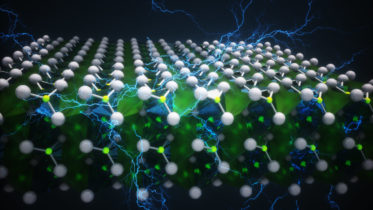A team of researchers have managed to grow ultra-thin material on silicon that can power small electronic devices
This post has been adapted from the UC Berkeley College of Engineering
As electronic devices become progressively smaller, the technology that powers them needs to get smaller and thinner.
One of the key challenges scientists face in developing this technology is finding materials that can perform well at an ultrathin size. But now, scientists think they may have the answer.
Led by Sayeef Salahuddin’s group at UC Berkeley, a team of researchers has managed to grow onto silicon an ultrathin material that demonstrates an electrical property called ferroelectricity. The team’s findings were published in the April 22 issue of Nature.
Ferroelectricity refers to a class of materials that can not only achieve spontaneous electric polarization, but also reverse its direction when exposed to an external electric field, which is promising for electronics.
The team’s breakthrough demonstrates ferroelectric effects in a material just 1 nanometer thick, equivalent to the size of just two atomic building blocks. As a result, the material can efficiently power the smallest of devices with lower amounts of energy.
“This is the first time ferroelectric switching has been demonstrated on such thin films,” says Jim Ciston, staff scientist at the Molecular Foundry, who led the electron microscopy portion of the project.

Right: Schematic detailing the ultrathin ferroelectric layer deposited on the silicon substrate and the capping metal layer.
The Berkeley team grew doped hafnium oxide, one nanometer thick, onto silicon and capped it with a layer of metal to trap its atoms in a ferroelectric arrangement. Not only did the ultrathin material demonstrate ferroelectricity, but the effect was actually stronger than the material several nanometers thicker.
The finding could lead to the creation of more advanced batteries and sensors. But the work is “especially relevant to next-generation low-power microelectronics,” said Ciston, such as memory and logic chips in computers.
This work was a collaborative effort by scientists from UC Berkeley, the Molecular Foundry and the Advanced Light Source at Lawrence Berkeley National Laboratory, the Advanced Photon Source at Argonne National Laboratory, the Stanford Synchrotron Radiation Lightsource at SLAC National Accelerator Laboratory, and Asylum Research.
Read more:
- “Researchers discover ferroelectricity at the atomic scale,” press release, UC Berkeley College of Engineering.
- “Enhanced ferroelectricity in ultrathin films grown directly on silicon,” journal article, Nature.
The Molecular Foundry is a Department of Energy (DOE) Office of Science User Facility, and a DOE Nanoscale Science Research Center (NSRC).


